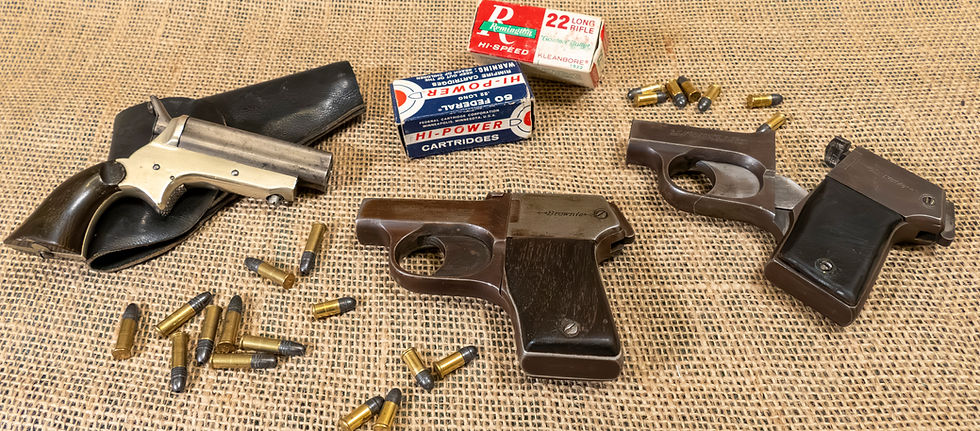Early pepperboxes worked with a spin
- kb5947
- Aug 31, 2025
- 4 min read
1860s and 1920s models packed ingenious engineering into small packages

By Kelly Bostian
If you’re going to pack a derringer, why not have four barrels instead of two?
In 1919, Oscar F. Mossberg and sons, Iver and Harold, launched what would become a firearms company well-known for its rifles and then shotguns, with a handy little four-barreled .22 caliber derringer named the Brownie.
Historic accounts note that O.F. Mossberg & Sons produced between 33,000 and 37,000 Brownies between 1920 and 1932.
That it is the first firearm made by a company that would become the oldest existing family firearms dynasty in the United States makes any Brownie a valuable link to firearms history. Iver and Harold took over the company after their father’s passing in the 1930s. The current CEO of O.F. Mossberg & Sons is A. Iver Mossberg, Jr., Oscar’s great-grandson.
The Brownie handled .22 short, long, and long rifle cartridges. It was widely marketed in the day as a trapper’s pocket gun, ideal for dispatching furbearers: a lightweight, handy, everyday-use tool available for a very reasonable $5.
Made sense. Back when fur was the height of fashion and the only good cowboy hat was made of beaver fur, every other family had at least one or two trappers chasing the local raccoons, minks, foxes, beavers, and bobcats.
Make no mistake, they were handy little self-defense guns, too.
Serious collectors note that prime specimens of the gun are pretty rare, because they were used as a workaday man’s tool and saw harsh conditions.
The most valuable samples feature original walnut grips and a slender, flat push-rod that is inserted into a small slot on the top of the gun, allowing it to slide down and be tucked inside the grip area when not in use. Expect any Brownie to come with a petina to the finish and signs of wear. If it has the original grips and push-rod still in place, you’ve got the complete package.
A rotating firing pin is at the heart of the relatively simple design of the Brownie. One of the Brownies in-house at J Gray’s Estate Firearm Services had hard leather grips, no doubt fashioned by some old trapper, which easily rotated aside for a view of the inner workings.
Not unlike our following subject, a stiff trigger pull against a spring-loaded mechanism allowed for double-action firing with a single pull of the trigger, with a nifty third action figured in – rotation of the firing pin.
Pull the trigger and the double-action of “cocking” the internal hammer and releasing it for the shot. However, as the hammer is cocked, a push arm rotates the firing pin, aligning it to hit the rim of the cartridge in the next barrel. With successive pulls of the trigger, the firing pin rotates like a clock, firing each barrel in succession.
A spring-loaded latch pressed at the top rear of the gun lifts a retainer to allow the four barrels to open forward for reloading.
In many ways, the Brownie was a modernized, double-action version of a pepperbox first made in 1859 by another highly recognized name in North American firearms, Sharps.
Christian Sharps, also a name better-known for rifles, designed a single-action, four-barreled, pocket-sized pistol that likely saved the lives of more than one Civil War combatant and helped aplenty in the Old West in many a last-ditch effort for survival.
The NRA Museum reports nearly 100,000 “Sharps Pepperbox” pistols rolled out of the factory from 1859 to 1874.
The single-action pistol’s firing pin is located on the front of the hammer, and, with each cock of the hammer, a lever slides up and turns the firing pin, and it locks in place to hit the rim of the next .22 short cartridge in the next barrel.
At half-cock, a spring-loaded release pin, located under the front edge of the pistol, can be pressed to release the barrel, which slides forward and off the frame for reloading.
Original Sharps pistols are marked and typically sport gutta-percha molded grips, but the pistol for sale now at J Grays sports some handsome horn grips, likely custom-made. The only markings on the gun are stamps of the number “14.”
That likely means it is one of many unmarked or “trade versions” patterned after the original Sharps in the later 19th or early 20th centuries. While not definitively a factory Sharps, any of the four-barrel models are interesting and collectible firearms that represent a historic evolution in firearms, and the horn grips on this beauty make it unique.
These guns can be viewed for sale currently in the J Grays EFS collection at Gunbroker.com







Comments